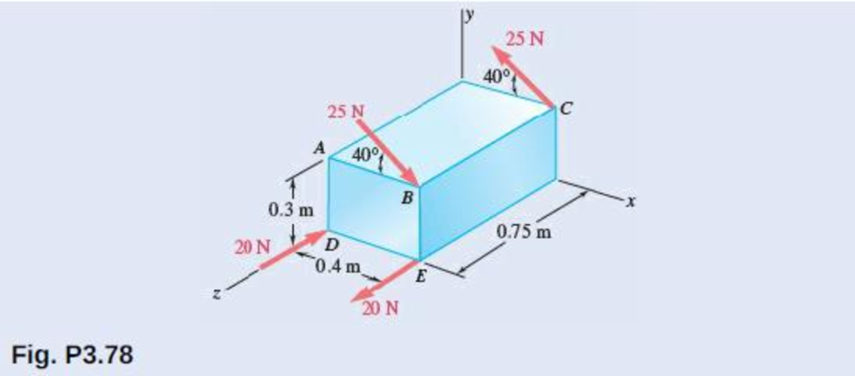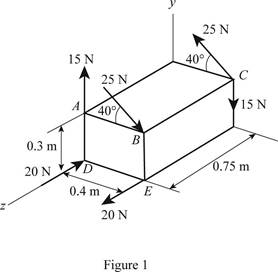
Solve part a of Prob. 3.78, assuming that two 15-N vertical forces have been added, one acting upward at A and the other downward at C.

(a)
The net couple acting on the rectangular co-ordinates.
Answer to Problem 3.79P
The net couple acting on the rectangular co-ordinates is
Explanation of Solution
Write the equation of the couple acting at the reactangular side
Here, moment of couple at the point
Substitute
Write the equation of the couple acting at the reactangular side
Here, moment of couple at the point
Substitute
Write the equation of the couple vector acting at the reactangular co-ordinates at point
Here, the projection angle is
Substitute
Write the equation of the couple vector acting at the reactangular co-ordinates at point
Substitute
Sketch the moment of additional couple is added to the moment about

Write the equation of the additional couple vector acting at the point
Here, the additional couple vector formed by the force at the point
The negative sign of the force shows that the force acting downward direction.
Substitute
Conclusion:
Write the equation for the net couple acting on the rectangular co-ordinates.
Adding the equations (I), (II), and (III) to obtained the net couple.
Write the equation for the magnitude of net couple.
Therefore, the net couple acting on the rectangular co-ordinates is
(b)
The direction of the two forces acting on the point
Answer to Problem 3.79P
The direction of the two forces acting on the point
Explanation of Solution
Write the equation for direction of the moment of couple formed by the forces at point
Here, the angle formed by the moment of couple due to the force located at the point
Rewrite the equation for
Write the equation for direction of the moment of couple formed by the forces at point
Here, the angle formed by the moment of couple due to the force located at the point
Rewrite the equation for
Write the equation for direction of the moment of couple formed by the forces at point
Here, the angle formed by the moment of couple due to the force located at the point
Rewrite the equation for
Conclusion:
Substitute
Substitute
Substitute
Therefore, the direction of the two forces acting on the point
Want to see more full solutions like this?
Chapter 3 Solutions
<LCPO> VECTOR MECH,STAT+DYNAMICS
- The manometer fluid in the figure given below is mercury where D = 3 in and h = 1 in. Estimate the volume flow in the tube (ft3/s) if the flowing fluid is gasoline at 20°C and 1 atm. The density of mercury and gasoline are 26.34 slug/ft3 and 1.32 slug/ft3 respectively. The gravitational force is 32.2 ft/s2.arrow_forwardUsing the Bernoulli equation to find the general solution. If an initial condition is given, find the particular solution. y' + xy = xy¯¹, y(0) = 3arrow_forwardTest for exactness. If exact, solve. If not, use an integrating factor as given or obtained by inspection or by the theorems in the text. a. 2xydx+x²dy = 0 b. (x2+y2)dx-2xydy = 0 c. 6xydx+5(y + x2)dy = 0arrow_forward
- Newton's law of cooling. A thermometer, reading 5°C, is brought into a room whose temperature is 22°C. One minute later the thermometer reading is 12°C. How long does it take until the reading is practically 22°C, say, 21.9°C?arrow_forwardSolve a. y' + 2xy = ex-x² b. y' + y sin x = ecosx, y(0) = −1 y(0) = −2.5arrow_forward= MMB 241 Tutorial 3.pdf 2/6 90% + + 5. The boat is traveling along the circular path with a speed of v = (0.0625t²) m/s, where t is in seconds. Determine the magnitude of its acceleration when t = 10 s. 40 m v = 0.0625² 6. If the motorcycle has a deceleration of at = (0.001s) m/s² and its speed at position A is 25 m/s, determine the magnitude of its acceleration when it passes point B. .A 90° 300 m n B 2arrow_forward
- = MMB 241 Tutorial 3.pdf 4/6 67% + 9. The car is traveling along the road with a speed of v = (2 s) m/s, where s is in meters. Determine the magnitude of its acceleration when s = 10 m. v = (2s) m/s 50 m 10. The platform is rotating about the vertical axis such that at any instant its angular position is u = (4t 3/2) rad, where t is in seconds. A ball rolls outward along the radial groove so that its position is r = (0.1+³) m, where t is in seconds. Determine the magnitudes of the velocity and acceleration of the ball when t = 1.5s.arrow_forwardThe population of a certain country is known to increase at a rate proportional to the number of people presently living in the country. If after two years the population has doubled, and after three years the population is 20,000, estimate the number of people initially living in the country.arrow_forward= MMB 241 Tutorial 3.pdf 6/6 100% + | 日 13. The slotted link is pinned at O, and as a result of the constant angular velocity *= 3 rad/s it drives the peg P for a short distance along the spiral guide r = (0.40) m, where 0 is in radians. Determine the radial and transverse components of the velocity and acceleration of P at the instant = 1/3 rad. 0.5 m P r = 0.40 =3 rad/sarrow_forward
- = MMB 241 Tutorial 3.pdf 1/6 90% + DYNAMICS OF PARTICLES (MMB 241) Tutorial 3 Topic: Kinematics of Particles:- Path and Polar coordinate systems and general curvilinear QUESTIONS motion. 1. Determine the acceleration at s = 2 m if v = (2 s) m/s², where s is in meters. At s = 0, v = 1 m/s. 3 m 2. Determine the acceleration when t=1s if v = (4t2+2) m/s, where t is in seconds. v=(4²+2) m/s 6 marrow_forward5.112 A mounting bracket for electronic components is formed from sheet metal with a uniform thickness. Locate the center of gravity of the bracket. 0.75 in. 3 in. ༧ Fig. P5.112 1.25 in. 0.75 in. y r = 0.625 in. 2.5 in. 1 in. 6 in. xarrow_forward4-105. Replace the force system acting on the beam by an equivalent resultant force and couple moment at point B. A 30 in. 4 in. 12 in. 16 in. B 30% 3 in. 10 in. 250 lb 260 lb 13 5 12 300 lbarrow_forward
 International Edition---engineering Mechanics: St...Mechanical EngineeringISBN:9781305501607Author:Andrew Pytel And Jaan KiusalaasPublisher:CENGAGE L
International Edition---engineering Mechanics: St...Mechanical EngineeringISBN:9781305501607Author:Andrew Pytel And Jaan KiusalaasPublisher:CENGAGE L
